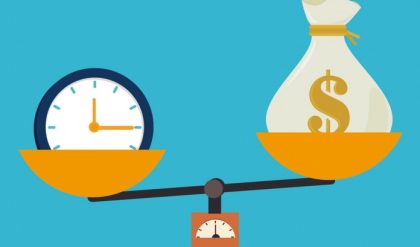The budget constraint framework helps to emphasize that most choices in the real world are not about getting all of one thing or all of another; that is, they are not about choosing either the point at one end of the budget constraint or else the point all the way at the other end. Instead, most choices involve marginal analysis, which means comparing the benefits and costs of choosing a little more or a little less of a good. People desire goods and services for the satisfaction or utility those goods and services provide. Utility, as we will see in the chapter on Consumer Choices is subjective but that does not make it less real.
Economists typically assume that the more of some good one consumes (for example, slices of pizza), the more utility one obtains. At the same time, the utility a person receives from consuming the first unit of a good is typically more than the utility received from consuming the fifth or the tenth unit of that same good. When Alphonso chooses between burgers and bus tickets, for example, the first few bus rides that he chooses might provide him with a great deal of utility—perhaps they help him get to a job interview or a doctor’s appointment. But later bus rides might provide much less utility—they may only serve to kill time on a rainy day. Similarly, the first burger that Alphonso chooses to buy may be on a day when he missed breakfast and is ravenously hungry.
However, if Alphonso has a burger every single day, the last few burgers may taste pretty boring. The general pattern that consumption of the first few units of any good tends to bring a higher level of utility to a person than consumption of later units is a common pattern. Economists refer to this pattern as the law of diminishing marginal utility, which means that as a person receives more of a good, the additional (or marginal) utility from each additional unit of the good declines. In other words, the first slice of pizza brings more satisfaction than the sixth. The law of diminishing marginal utility explains why people and societies rarely make all-or-nothing choices. You would not say,
“My favorite food is ice cream, so I will eat nothing but ice cream from now on.” Instead, even if you get a very high level of utility from your favorite food, if you ate it exclusively, the additional or marginal utility from those last few servings would not be very high. Similarly, most workers do not say: “I enjoy leisure, so I’ll never work.” Instead, workers recognize that even though some leisure is very nice, a combination of all leisure and no income is not so attractive. The budget constraint framework suggests that when people make choices in a world of scarcity, they will use marginal analysis and think about whether they would prefer a little more or a little less.
Sunk Costs
In the budget constraint framework, all decisions involve what will happen next: that is, what quantities of goods will you consume, how many hours will you work, or how much will you save. These decisions do not look back to past choices. Thus, the budget constraint framework assumes that sunk costs, which are costs that were incurred in the past and cannot be recovered, should not affect the current decision.
From a Model with Two Goods to One of Many Goods
The budget constraint diagram containing just two goods, like most models used in this book, is not realistic. After all, in a modern economy people choose from thousands of goods. However, thinking about a model with many goods is a straightforward extension of what we discussed here. Instead of drawing just one budget constraint, showing the tradeoff between two goods, you can draw multiple budget constraints, showing the possible tradeoffs between many different pairs of goods. Or in more advanced classes in economics, you would use mathematical equations that include many possible goods and services that can be purchased, together with their quantities and prices, and show how the total spending on all goods and services is limited to the overall budget available. The graph with two goods that was presented here clearly illustrates that every choice has an opportunity cost, which is the point that does carry over to the real world.





